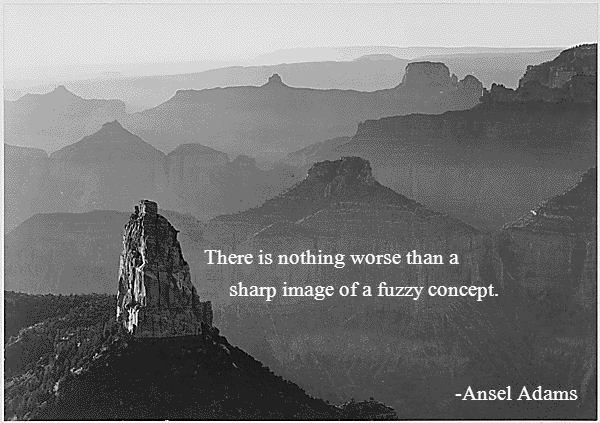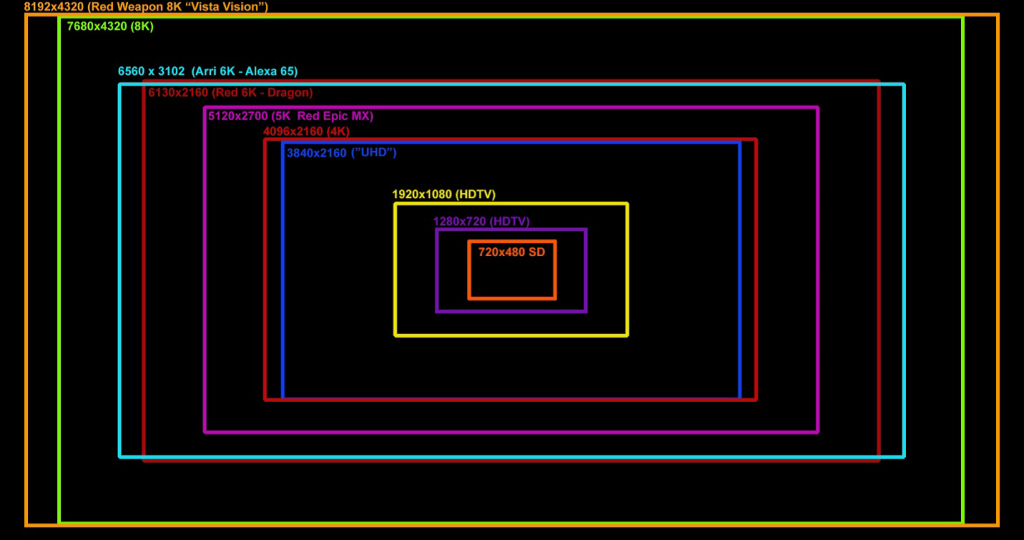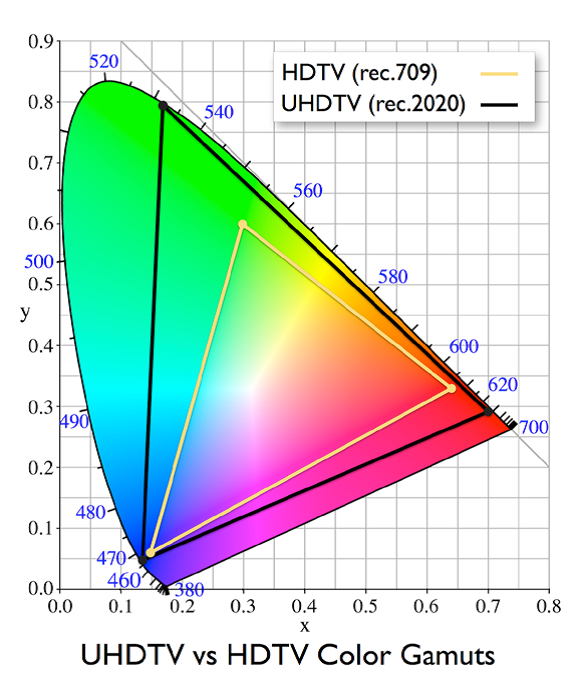< Back to all posts
Why You Should Transition to 8K Now
The motion picture camera manufacturing business moves at a frenetic pace. It’s extremely hard to keep up with the “latest and greatest cameras.” 2016 is destined to be the year of 8K. That’s right, read it again, 8k. I know what many are thinking: “What do you mean 8K? We’re still at 1080, and we’re just now thinking about moving to 4K?”
Other phrases I hear often are: “The human eye can’t see beyond 4K, so this is a waste! When will it stop?” or “This race for resolution is ridiculous!”
The truth of the matter is, this is not a new concept. Some of the greatest photographers have used this “over-sampling” concept for over 100 years! In fact Ansel Adams primarily used large-format cameras because their high resolution helped ensure sharpness to his images. No one has ever said “Ansel Adams’ images look too sharp!” In fact, it’s quite the contrary! His images look smooth, clean and have a spacial depth to them because they were shot in an ‘over sampled’ fashion.

Nearly all “magazine” cover shots, advertising and “feature pieces” are shot today with “medium-format” cameras; first with 120/220 film, and now digitally. The arguments for medium-format over DSLR are: image quality, color depth and image feel. Many believe that comparing an image taken by each format, side by side, the images just don’t look the same. (Does this argument sound familiar?)
The question is “why do photographers over sample their images?” Quite simply, it’s control of the final image! When you over-sample an image, by shooting a larger format, you gain resolution. That gain is extremely apparent when the final image is down-scaled and the grain becomes “tighter” in the final presentation. It short, it will look sharper, cleaner and more pleasing to the eye.
Another reason to over-sample is the ability to edit the image in post. The image can be ‘re-framed’ when conforming to a smaller resolution. Of course the photography purists would hate hearing this concept, but it does happen and more often than many realize.

We are now in the dawn of a new age of motion imaging. Like it or not the ‘new standard’ for content delivery and home entertainment will be “UHD-TV.” (3840×2160). In a similar fashion to HDTV, the transition will more than likely take a decade to fully embrace; we’re already a few years into the transition! As this adaptation comes into mainstream, so will the delivery methods in which we receive content.
I’ve said for quite a few years that ‘broadcasters’ will yield to “OTT” content providers. (Over the Top refers to the delivery of audio and video signals over the internet without the involvement of a multiple-system operator in the control or distribution of content.) Netflix, Amazon, and YouTube Red have ventured into this arena, bravely before anyone else, and their successes are paving the way for future content providers. To future proof their content, Netflix and Amazon are mandating that the minimum standard for their original content be acquired in 4K. These standards are likely to continue to change as technology advances. Unlike their broadcasting counterparts, OTT content providers are able to upgrade their distribution and exhibition systems with relatively inexpensive software upgrades. These upgrades can be performed quickly and easily. Some broadcasters are stuck in a 720p infrastructure with the upgrades being so vast and so expensive, they’d rather be complacent than move forward with technology; this will be their downfall.
New televisions for home use have new features. Not only are televisions “smart” these days, their information path is ‘bi-directional’. If you’ve shopped for a TV recently, you’ll notice that many use new terms that include UHD, HDR and WCG. Ultra-High Definition is the consumer standard for 4K delivery and is slightly smaller than ‘true 4K.’ (It’s also a fixed aspect ratio of 16:9). High Dynamic Range images will provide more detail from the darkest points to the brightest points in the image. The goal is to replicate what the human eye can discern visually. A Wide Color Gamut (known as “Rec2020”) will increase the possible colors that can be represented on television. Colors in the new standard will also appear ‘richer’ as well. The current standard is “Rec 709” for HDTV. The human eye can see colors far beyond what is possible on today’s HDTV televisions. WCG narrows that gap. None of these ‘new features’ are available on HDTV’s or in the current broadcasting standards. Many network broadcasters feel that the ability to implement these aspects as standards will be impossible; this paves the way for new content delivery services and cements OTT.

Unlike the transition from SD to HD, the transition from HD to UHD/4K will not allow for the up scaling of images; the image is 4x larger and up scaling would degrade the HDTV signal beyond a usable state. Therefore to preserve the economic feasibility of content, providers are already acquiring media at a minimum of 4K.
Many still shoot in HD and claim that the image is beautiful. This is true when you’re looking at a monitor on set. This is even more apparent when that image is acquired from a large sensor camera and then down-sampled. Many forget that along the way the signal is degraded so much that it doesn’t resemble that beautiful image at the time of creation. Often images are conformed to standards, compressed, transmitted/delivered, decompressed and then consumed (sometimes after being compressed again!) and this can take an awful toll not only on the appearance of the image but quality of the image. By moving into a “UHD” world, we embrace the UHD, HDR and WCG standards which ensure the quality of your original content stays the same throughout the process.
Like our still photographer counterparts, motion imaging professionals need to learn how to accept and approve the over-sample! When 4K acquisition started becoming popular in 2008, many fell in love with the image, even though the majority of the presentations were shown in 2K. It was the down-sampling of content that showcased the 4K sensor. As OTT standards become the “mainstream/normal,” we should once again embrace the tools afforded to us with 8K image capture (including down-sampling, and reframing specifically). Too often the 8K image capture term is being mistakenly thought of as a bragging right instead of an effective tool that ensures longevity and return of investment.

I know that many folks think that resolution is sharpness. They don’t want to move from 1080 to 4K because they feel that the image will be ‘over-sharp.’ Certainly they don’t want to make the leap to 8K, because they feel that it would be unbearable to watch, especially when watching people. However, there are a few things that need to be clarified so that one can understand what is happening on a digital image. For starters, every object displayed is created with a series of polygons. It’s very difficult to make rounded objects when you’re using polygons, therefore making a perfect circle on a digital imaging sensor is nearly impossible. When we used film and videotape, we could make perfect circles because those mediums were not limited to polygon arrangements. What the increase of resolution affords us is the increase in pixels and polygons. The more pixels you can apply to images, especially those with “rounded edges,” the more perfect they appear. The result equates to smoothness, not sharpness. The same holds true with 8K acquisition.
Since the 1970s, when video tape was introduced, content creators have wanted a viable and affordable alternative to film. They love the look and feel of film, just not the price. Part of the look and feel they are so attracted to is that ‘smoothness.’ For years manufacturers strove to recreate that smoothness of film cameras. In the past several years many believe film has been matched by the high level 4K cameras on the market. With 8K film will be surpassed.
There are a few flavors of 8K hitting the market. The first camera to employ an 8K sensor was Sony’s F65 camera, although it recorded a 4K image. This has been their flagship camera since 2012. It is rumored that Sony will present a new flagship in 2016 that captures in 8K as well. Sony has long been a firm believer in over-sampling, so it’s anyone’s guess if they’ll surpass 8K for image sensor size.
The first camera to be released that actually shoots 8K is the Red Digital Cinema Weapon. The camera is currently shipping in limited quantities. (It will start shipping on a larger scale in the beginning of Q2, 2016). The first large scale project to be completely captured in 8K is Marvel’s “Guardians of the Galaxy II.”
Canon have also displayed an 8K version of their Cine EOS line, as a prototype, that looks promising. The only issue with this prototype is that it must use four Convergent Design Odyssey 7Q’s to be able to actually record in 8K. This makes the camera almost unwieldy on set. Perhaps Canon will find a better method of recording before release.
A slightly smaller “large sensor” camera is Arri’s Alexa 65. (This camera isn’t for sale, it’s a rental item only.) The Alexa 65 has already been used on a few films, such as The Revenant.
The biggest challenge with any of these extremely large sensor cameras is glass. What lenses actually work with the camera systems? Arri has rehoused some Medium Format lenses. Canon is making entirely new lenses to cover the enormous 8K sensors. For those shooting with Red cameras, any lens that covers ‘full frame’ 35mm will work, which generally means FF35mm and Medium Format lenses. The Zeiss Otus and Milvus line cover 8K. Nearly all of the Medium Format lenses by Hasselblad, Mamiya, Pentax, etc. are finding new life in the large sensor motion picture arena. It takes a few moments to get a ‘feel’ for the depth of field when shooting with these still lenses in the 8K world. It’s not impossible to master; one just has to be mindful.
I am one of the folks that believe over-sampling my image capture truly sets my work apart from the competition. My company, azPTP has already purchased a Red Weapon. We are “in line” to get the 8K Weapon upgrade as soon as it’s available. I believe that UHD/4K will be the mezzanine standard for quite some time, and I want to afford my clients the best possible image with the longest return on their investment.
The only way to truly evaluate something new is to see it in action. If you aren’t afforded the opportunity to actually see an 8K camera in use, check out one of the first videos posted on the internet that was acquired in 8K with the Red Weapon. It’s truly spectacular! Bear in mind that the compression of this presentation on YouTube doesn’t even do the project justice, but it still looks stunning!
If you’d like to bring this type of quality to your imaging, consider making the move into 8K image capture. In the words of Ansel Adams: “You don’t take a photograph, you make it.”







I have known Curt for many years and he is always ahead of what is happening in our business. He has never been wrong about tech he lives this stuff if he talking about he owns it and using it. You listen to who you want I listen to him. Well said Curt. Look him up he has great equipment videos on line.
Nice well written article and a great video piece!
Yes this is beautiful, but will the industry support the additional cost and slower workflows? There have been superior technologies in motion picture films before but the reality is that few projects could support it financially and it fell out of favor. There are less expensive ways to "punch in and out" than buying and 8K camera and all that it takes to support it.
I agree !